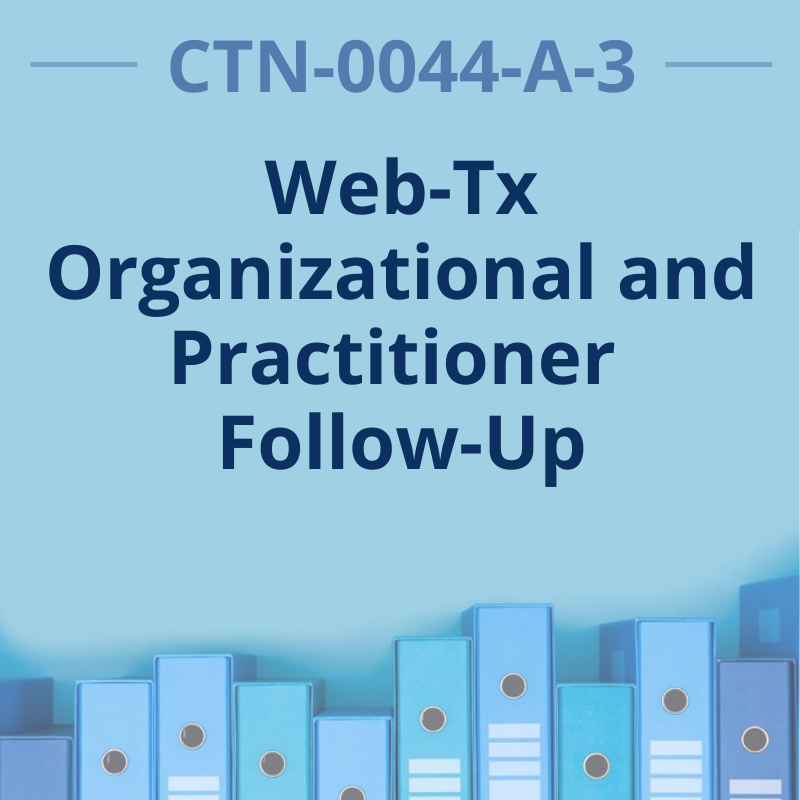CTN-0044-A-3: Acceptability of a Web-delivered, Evidence-based, Psychosocial Intervention among Individuals with Substance Use Disorders who Identify as American Indian/Alaska Native

Aimee Campbell, PhD, MSW
Co-Lead Investigator
New York State Psychiatric Institute, Columbia University
anc2002@columbia.edu
Traci Rieckmann, PhD
Co-Lead Investigator
Oregon Health & Science University
rieckman@ohsu.edu
Little is known about how computer-assisted interventions function within clinical treatment settings, provider attitudes towards this technology, and attitude changes of those providers over time. This ancillary study takes advantage of an opportunity to collect data over time from practitioners who have been exposed to an innovative computer-based therapy, the Therapeutic Education System (TES), through the addition of two follow-up surveys. Findings from this study will provide key insights into practitioner attitudes toward technological innovation, and identify important factors related to adoption and implementation, such as organizational characteristics, climate, and culture. Specific aims: 1) Assess change in practitioner attitudes, social norms, and intentions related to computer use, internet use, and web-based interventions from baseline (pre-protocol implementation) to follow-up 1 (post-study treatment completion) and follow-up 2 (post-study outcomes sharing). It is hypothesized that practitioner attitudes, social norms, and intentions will become more positive over time. 2) Assess change in practitioner attitudes, social norms, and intentions related to computer use, internet use, and web-based interventions as a function of number of clients participating in TES and providers’ perceived usefulness of TES for the client. It is hypothesized that practitioner attitudes, social norms, and intentions will be positively associated with the number of TES clients assigned and perceived usefulness. 3) Explore the association between practitioner attitudes, social norms, intentions, and organizational variables (readiness, climate, organizational characteristics) at follow-up 1 and follow-up 2. 4) Describe changes in organizational factors (readiness, climate, organizational characteristics) which may serve as facilitators or barriers for adoption or implementation of the computer-assisted intervention TES.
Primary Findings
The study examined uptake of HIV testing among 1,224 clients in five SUD treatment units that offered on-site testing. Nearly one third of the participants reported not having been tested for HIV within the past twelve months. Women, African Americans, and injection drug users had a higher likelihood of having been tested within the past twelve months. The SUD treatment program was the most frequently identified location of participants’ last HIV test. Despite the availability of free, on-site testing, a substantial proportion of clients were not tested, suggesting that strategies to increase uptake of testing should include addressing barriers not limited to location and cost.

Results Article: Kyle TL, et al. Uptake of HIV Testing in Substance Use Disorder Treatment Programs That Offer On-Site Testing. AIDS and Behavior 2015;19(3):536-542. [get article]
Related Studies
- CTN-0044: Web Delivery of Evidence-Based, Psychosocial Treatment for Substance Use Disorders
- CTN-0044-A-1: Site Influences on Treatment Effects – Web-delivery of Evidence-Based, Psychosocial Treatment for Substance Use Disorders
- CTN-0044-A-2: Acceptability of a Web-Delivered, Evidence-Based, Psychosocial Intervention Among Individuals with Substance Use Disorders Who Identify as American Indian/Alaska Native
Related Resources
Node Involvement
Lead Node(s):
All Participating Nodes: